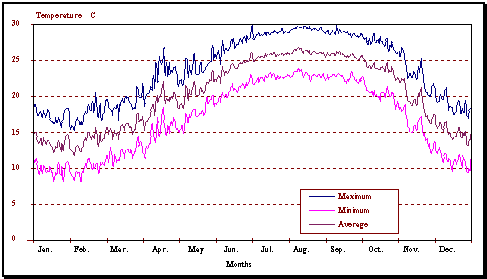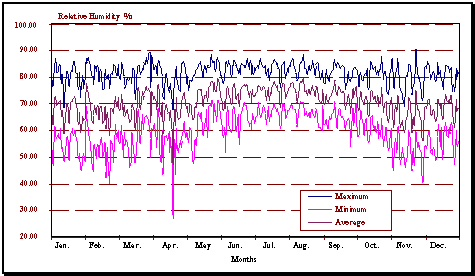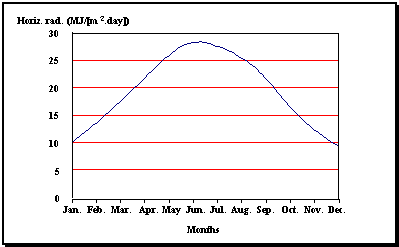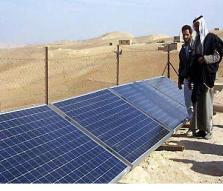-
Setting policies with regard to the energy conservation and to
exploit the advantages of its resources in Palestine.
-
To start
laying out plans and special studies related with Palestinian rural
electrification (solar and wind energy).
-
Establishing
modern and developed meteorological station to collect climate data throughout
the year like temperature, relative humidity, solar radiation, sunshine-hour,
wind speed and its direction, in which to be the core in establishing the Atlas
of climate data in Palestine
-
Establishing
test labs to select specific equipment’s in renewable energy in particular,
solar and wind energy.
-
To
exchange experiences at locally and international level with institution and
research centers in renewable energy fields.
-
To
participate in seminars, workshops at local and international level.
The Gaza Strip is a narrow strip stretches
along the east-south corner of the Mediterranean Sea , 40
km long and between 6 and 12 km wide. It lies on Longitude 34o
26` east and Latitude 31o 10` north of the equator. The total area is
estimated at 365 km2 . The Gaza Strip is highly populated with an estimated population of
850,000 and can be divided into major cities, refugee camps and villages. The
average population density is 2330 person / km2
, while the highest, which is registered in the camps can be 100,000 person / km2.
The Gaza Strip is categorized as tropical region with a relatively hot
summer and mild winter.
Temperature
The average daily mean temperature ranges from 24oC
in summer [May-August], to 15oC in
winter [November-February] Fig.(1). Average daily maximum temperatures range
from 27oC to 19oC and minimum
temperatures from 21oC to 11oC,
in the summer and winter respectively.

Figure (1): Temperatures in
oC, Gaza Strip
Relative Humidity
The daily relative humidity Fig. (2) fluctuates between 62.5% in the
daytime and 83.4% at night in the summer, and between 51.6% and 81.3%,
respectively, in winter.

Figure (2): Relative Humidity in %, Gaza Strip
Gaza
Strip has a relatively high solar radiation. It has approximately 2861, annual
sunshine -hour sunshine throughout the year. The daily average solar radiation
on a horizontal surface is about 222 W/m2 (7014 MJ/m2/yr).
This varies during the day and through out the year Fig (3). Illustrates the
variation in the monthly daily average in total insolation on horizontal surface
for each month.

Figure (3) : Annual variation in solar radiation
In the Gaza Strip
Thermal transfer for solar energy:
Domestic solar water heating
(SWH) is widely used in Palestine, it can be safely estimated that at least 70
percent of houses in Palestine have installed such system.
SWH are manufactured locally by
more than 15 major workshops in Palestine, 10 of them in West Bank and 5 in Gaza
Strip.
The currents annul production
rate of these workshops is estimated at about 24.000 units, this production rate
is sufficient to full fill the local market’s need. It is expected that this
market will expand due to significant growth in the building sector.
The average cost for typical flat
plate solar collector is about 300 $.
Analysis can show that the system
pay back period based on the electricity price, is less than 2 years, (about 1.3
years)
Solar water heaters have proved
to be feasible compared with other alternatives. For example, the energy cost
from solar heater is about $ 0.17/Kwh energy much cheaper that the electricity
price from the grid, $0.11/Kwh. In view
of the importance of these models and its application in providing energy and
the high demand for in the local market, and its application over spread in
Palestinian territories.
Hence the renewable energy department in PEA, made the major
priority in which it has been coordinated with the Palestinian standards
institution in industrial ministry for the efficient performance, and to unified
models and special stander, in solar models however it has been signed agreement
between the two institutions for establishing test lab for the efficiency and
performance to all types of models.

Inspecting part of the new school solar array is
Mr.Mahmoud Al-Majada(left).He commented that this solar power plant is
the fulfillment of great dream held by the village Council for leaping
into the 21st Century at full speed.
|
Photovoltaic transfer for solar
energy:
The average electric lead in a
clinic amounts to approximately 2.4 Kw/day, and is utilized for lighting,
medicinal refrigeration and the operation of medical testing equipment. Since a
large number of clinics located in remote villages have no electricity at all,
such electricity loads can be easily and reliably covered by a small PV
generator with a peak power of only 400 W and a storage battery black capacity
of 7.2 Kwh .
This alternative was applied to
nine clinics in remote villages in Palestine, and proved to be a viable solution
in such cases.
It is expected that about 30 PV
generators, corresponding to a peak of about 15KW
